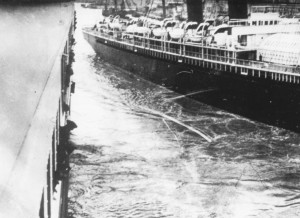It was an immense day in the life of the Titanic. April 10th is when she set off from England to begin her 7-day maiden voyage; the beginning of her ending.
The White Star Line made very little of the Titanic's departure. There were no bands, no speeches, no flag-waving. The only touch out of the ordinary was an immense crowd. Southampton was a seafaring town, and it seemed that the whole city wanted to watch the greatest ship in the world start off on her maiden voyage. But it was a knowledgeable crowd, almost professionally observant, and not at all given to singing or cheering.
('The Night Lives On' by Walter Lord, page 34)

The photograph above shows some of the Titanic's passengers boarding.
A collision almost struck the very hour that the Titanic left her berth in Southampton. She traveled down the channel towards the open sea, by assistance of 6 tugboats. Once the tugboats released the Titanic, she was on her own, steaming through the water. She passed through a narrow part of the channel right beside 2 other (smaller) ocean liners that were tied together, which were the White Star Line's Oceanic & the American Line's New York.
The Titanic glided on, steaming at about six knots. As she drew opposite the New York, there was a sudden series of sharp cracks, like pistol shots. One after another, all six of the lines tying the New York to the Oceanic snapped. Drawn by some inexorable force, the American Liner began drifting toward the huge Titanic. For a moment a collision seemed certain, as the stern of the New York swung to within three or four feet of the port quarter of the Titanic.
Quick thinking saved the day. The tug Vulcan, one of the small fleet escorting the Titanic, darted to the danger spot. Her skipper, Captain Gale, passed a line to the New York's stern, and with much puffing and straining, the Vulcan managaed to slow the vessel's drift.
('The Night Lives On' by Walter Lord, page 36)
 The New York came dangerously close, two ships coming within inches of each other. Because the Titanic was so huge, she displaced 52,310 tons of the water surrounding her, which created a suction effect. This was the consequence of creating such gigantic ocean liners. The near-collision with the New York could have been fatal, but thankfully, the situation was averted. The photo to the left shows, from a camera on the Titanic, just how close the New York was getting.
The New York came dangerously close, two ships coming within inches of each other. Because the Titanic was so huge, she displaced 52,310 tons of the water surrounding her, which created a suction effect. This was the consequence of creating such gigantic ocean liners. The near-collision with the New York could have been fatal, but thankfully, the situation was averted. The photo to the left shows, from a camera on the Titanic, just how close the New York was getting.
Be here tomorrow, for an inside look at the Titanic, and what the passengers would have seen as they entered on April 10th.













0 written notes {Post a Comment}:
Post a Comment